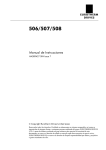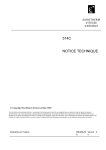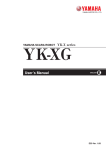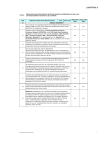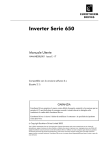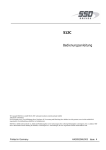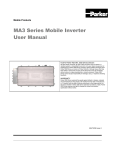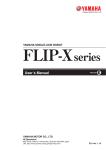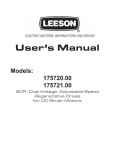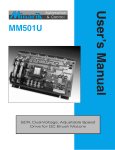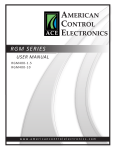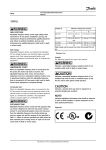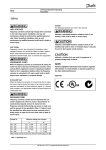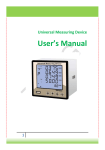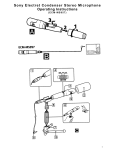Download 512C Series
Transcript
512C Series Converter Technical Manual HA389196 Issue 10 Copyright 2013 Parker Hannifin Hannifin Ltd. All rights strictly reserved. No part of this document may be stored in a retrieval system, or transmitted in any form or by any means to persons not employed by a Parker Hannifin Manufacturing Limited company without written permission from Parker Hannifin Manufacturing Ltd. Although every effort has been taken to ensure the accuracy of this document it may be necessary, without notice, to make amendments or correct omissions. Parker Hannifin Manufacturing Limited cannot accept responsibility for damage, injury, or expenses resulting therefrom. WARRANTY Refer to Parker Hannifin Manufacturing Limited Terms and Conditions of Sale. These documents are available on request at www.parker.com. Parker Hannifin Manufacturing Limited reserves the right to change the content and product specification without notice. FAILURE OR IMPROPER SELECTION OR IMPROPER USE OF THE PRODUCTS DESCRIBED HEREIN OR RELATED ITEMS CAN CAUSE DEATH, PERSONAL INJURY AND PROPERTY DAMAGE. This document and other information from Parker-Hannifin Corporation, its subsidiaries and authorized distributors provide product or system options for further investigation by users having technical expertise. The user, through its own analysis and testing, is solely responsible for making the final selection of the system and components and assuring that all performance, endurance, maintenance, safety and warning requirements of the application are met. The user must analyze all aspects of the application, follow applicable industry standards, and follow the information concerning the product in the current product catalog and in any other materials provided from Parker or its subsidiaries or authorized distributors. To the extent that Parker or its subsidiaries or authorized distributors provide component or system options based upon data or specifications provided by the user, the user is responsible for determining that such data and specifications are suitable and sufficient for all applications and reasonably foreseeable uses of the components or systems. Cont.- 2 Requirements IMPORTANT: Please read this information BEFORE installing the equipment. Intended Users This manual is to be made available to all persons who are required to install, configure or service equipment described herein, or any other associated operation. The information given is intended to highlight safety issues, EMC considerations, and to enable the user to obtain maximum benefit from the equipment. Complete the following table for future reference detailing how the unit is to be installed and used. INSTALLATION DETAILS Serial Number (see product label) Where installed (for your own information) Unit used as a: (refer to Certification for the Converter) Component Relevant Apparatus Unit fitted: Wall-mounted Enclosure Application Area The equipment described is intended for industrial motor speed control utilising DC Shunt Wound or DC Permanent Magnet Motors. Personnel Installation, operation and maintenance of the equipment should be carried out by qualified personnel. A qualified person is someone who is technically competent and familiar with all safety information and established safety practices; with the installation process, operation and maintenance of this equipment; and with all the hazards involved. Product Warnings Caution Risk of electric shock Caution Refer to documentation Earth/Ground Protective Conductor Terminal Cont. - 3 Hazards DANGER! - Ignoring the following may result in injury 1. This equipment can endanger life by exposure to rotating machinery and high voltages. 2. The equipment must be permanently earthed due to the high earth leakage current, and the drive motor must be connected to an appropriate safety earth. 3. Ensure all incoming supplies are isolated before working on the equipment. Be aware that there may be more than one supply connection to the drive. 4. There may still be dangerous voltages present at power terminals (motor output, supply input phases, DC bus and the brake, where fitted) when the motor is at standstill or is stopped. 5. For measurements use only a meter to IEC 61010 (CAT III or higher). Always begin using the highest range. CAT I and CAT II meters must not be used on this product. 6. Allow at least 5 minutes for the drive's capacitors to discharge to safe voltage levels (<50V). Use the specified meter capable of measuring up to 1000V dc & ac rms to confirm that less than 50V is present between all power terminals and earth. 7. Unless otherwise stated, this product must NOT be dismantled. In the event of a fault the drive must be returned. Refer to "Routine Maintenance and Repair". WARNING! - Ignoring the following may result in injury or damage to equipment SAFETY Where there is conflict between EMC and Safety requirements, personnel safety shall always take precedence. • Never perform high voltage resistance checks on the wiring without first disconnecting the drive from the circuit being tested. • Whilst ensuring ventilation is sufficient, provide guarding and /or additional safety systems to prevent injury or damage to equipment. • When replacing a drive in an application and before returning to use, it is essential that all user defined parameters for the product’s operation are correctly installed. • All control and signal terminals are SELV, i.e. protected by double insulation. Ensure all external wiring is rated for the highest system voltage. • Thermal sensors contained within the motor must have at least basic insulation. • All exposed metalwork in the Inverter is protected by basic insulation and bonded to a safety earth. • RCDs are not recommended for use with this product but, where their use is mandatory, only Type B RCDs should be used. EMC • In a domestic environment this product may cause • This is a product of the restricted sales distribution class radio interference in which case supplementary mitigation measures may be required. • This equipment contains electrostatic discharge (ESD) sensitive parts. Observe static control precautions when handling, installing and servicing this product. according to IEC 61800-3. It is designated as “professional equipment” as defined in EN61000-3-2. Permission of the supply authority shall be obtained before connection to the low voltage supply. CAUTION! APPLICATION RISK • The specifications, processes and circuitry described herein are for guidance only and may need to be adapted to the user’s specific application. We can not guarantee the suitability of the equipment described in this Manual for individual applications. RISK ASSESSMENT Under fault conditions, power loss or unintended operating conditions, the drive may not operate as intended. In particular: • Stored energy might not discharge to safe levels • The motor's direction of rotation might not be controlled as quickly as suggested, and can still be present • The motor speed might not be controlled even though the drive appears to be switched off • The motor might be energised A drive is a component within a drive system that may influence its operation or effects under a fault condition. Consideration must be given to: • Stored energy • Supply disconnects • Sequencing logic • Unintended operation Cont.- 4 Contents Contents CHAPTER 1 GETTING STARTED Page 1-1 Introduction .................................................................................................. 1-1 Optional Equipment................................................................................................... 1-1 Equipment Inspection ................................................................................... 1-1 About this Manual ........................................................................................ 1-2 Initial Steps ................................................................................................................ 1-2 How the Manual is Organised .................................................................................... 1-2 CHAPTER 2 AN OVERVIEW OF THE CONVERTER 2-1 Component Identification ............................................................................. 2-1 Control Features............................................................................................ 2-2 Understanding the Product Code ................................................................. 2-3 CHAPTER 3 INSTALLING THE CONVERTER 3-1 Mechanical Installation ................................................................................ 3-1 Mounting the Converter ............................................................................................. 3-2 Electrical Installation .................................................................................... 3-4 Recommendations ..................................................................................................... 3-4 CHAPTER 4 OPERATING THE CONVERTER 4-1 Pre-Installation Planning ............................................................................. 4-1 Basic Wiring Diagrams .............................................................................................. 4-1 Setting-Up & Commissioning ........................................................................ 4-2 Option Switches ......................................................................................................... 4-2 Potentiometers ........................................................................................................... 4-3 Basic Setting-Up Procedure .......................................................................... 4-4 Preparation ............................................................................................................... 4-4 CHAPTER 5 LED INDICATIONS 5-1 LED Indications ............................................................................................. 5-1 CHAPTER 6 TERMINAL DESCRIPTIONS 6-1 Control Terminals ...................................................................................................... 6-1 Power Terminals ........................................................................................................ 6-2 Field Terminals (Auxiliary Supply) ............................................................................... 6-2 CHAPTER 7 FAULT FINDING 7-1 Troubleshooting ............................................................................................ 7-1 CHAPTER 8 ROUTINE MAINTENANCE & REPAIR 8-1 Routine Maintenance .................................................................................... 8-1 Cont. - 5 Contents Contents Page Repair ........................................................................................................... 8-1 Returning the Unit to Parker Hannifin Manufacturing Limited ....................................... 8-1 Disposal .................................................................................................................... 8-1 CHAPTER 9 REPLACEMENT OF 512 WITH 512C 9-1 512C/512 Terminal Differences .................................................................... 9-1 Functional Differences 512C & 512 ............................................................... 9-2 CHAPTER 10 BLOCK DIAGRAM 10-1 Block Diagram ............................................................................................ 10-1 CHAPTER 11 TECHNICAL SPECIFICATIONS 11-1 Environmental Requirements ..................................................................... 11-1 Operating Conditions ................................................................................. 11-1 Electrical Ratings ...................................................................................................... 11-3 CHAPTER 12 CERTIFICATION FOR THE CONVERTER 12-1 EMC and the 'CE' Mark ................................................................................ 12-1 'CE' EMC Responsibility ............................................................................................ 12-1 Special Considerations for Installations Requiring Compliance with UL Standards ...... 12-2 Certificates .............................................................................................................. 12-3 Cont.- 6 Getting Started 1-1 Chapter 1 GETTING STARTED Introduction The 512C converter is intended for use in an Industrial Environment, it should be mounted within an enclosure which provides protection to the converter and the user. The converter should be permanently earthed at the terminals provided. The 512C converter is suitable for the control of Permanent Magnet and Shunt Wound DC Motors. The converters are designed to operate from a single phase ac mains supply in the range of 110Vac to 415Vac at 50 or 60Hz. A simple transformer tap arrangement allows the converter to be programmed to suit the applied voltage. The Speed of the DC Motor is controlled using a linear closed loop system with a feedback signal from either tachogenerator or armature voltage, the feedback source being switch selectable. A current loop within the speed loop always ensures that controlled levels of current are applied to the motor, actual levels being scaleable via programmable switches. Motor protection is provided by a Stall detection circuit which will remove current from the motor after approximately 60 seconds. Converter protection is provided by a Instantaneous Overcurrent trip circuit overriding control in the event of a Short Circuit. Optional Equipment Item Part Number UL Compression Lug Kits See page 12.3 for more information. External AC Supply (RFI) Filter For 512C units without internal filters, on cable runs in excess of 25 metres Fuse Isolator Kit High speed semi-conductor fuses are recommended. LA389745U016 LA389745U032 Refer to Chapter 3 for Part Numbers See table 11.1 for part numbers. Table 1-1 Optional Equipment Equipment Inspection • • Check for signs of transit damage Check the product code on the rating label conforms to your requirement. If the unit is not being installed immediately, store the unit in a well-ventilated place away from high temperatures, humidity, dust, or metal particles. Refer to Chapter 2: “An Overview of the Converter” to check the rating label/product code. Refer to Chapter 8: “Routine Maintenance and Repair” for information on returning damaged goods. Refer to Chapter 11: "Technical Specifications" - Environmental Details for the storage temperature. 512C Series Converter 1-2 Getting Started About this Manual This manual is intended for use by the installer of the 512C converter. It assumes a reasonable level of understanding in these disciplines. Note: Please read all Safety Information before proceeding with the installation and operation of this unit. Enter the “Model No” from the rating label into the table at the front of this manual. It is important that you pass this manual on to any new user of this unit. This manual is for the following models from the 512C Converter Series: 512C-04 4A DC Full Load Current 512C-08 8A DC Full Load Current 512C-16 16A DC Full Load Current 512C-32 32A DC Full Load Current Initial Steps Use the manual to help you plan the following: Installation Know your requirements: • certification requirements, CE/UL/CUL conformance • mount in an enclosure • conformance with local installation requirements • supply and cabling requirements How the Manual is Organised The manual is divided into chapters and paragraphs. Page numbering restarts with every chapter, i.e. 5-3 is Chapter 5, page 3. 512C Series Converter An Overview of the Converter 2-1 Chapter 2 AN OVERVIEW OF THE CONVERTER Component Identification CONTROL TERMINAL BLOCK T24 T1 1 ON LED 1 2 3 P1 P8 HEALTH LEDS OFF POTENTIOMETERS LED1 - STALL TRIP LED2 - POWER ON P1 - RAMP UP P2 - RAMP DOWN LED3 - OVERCURRENT TRIP P3 - SPEED STABILITY 8 CONTROL PCB SWITCHES P4 - CURRENT LIMIT P5 - IR COMPENSATION 512C P6 - MINIMUM SPEED P7 - MAXIMUM SPEED P8 - ZERO SPEED OFFSET 380/415V 220/240V AUX 110/120V MAINS TRANSFORMER TAPPING LINK LEGEND PLATE MAINS OR AUXILIARY SUPPLY SELECTOR HEATSINK FIXING POINTS POWER TERMINALS FIELD TERMINALS & AUXILIARY SUPPLY PROTECTIVE GROUND Figure 2-1 View of Component Parts 512C Series Converter 2-2 An Overview of the Converter Control Features Speed Control Control Action Closed Loop with Proportional Integral Control and Adjustable Stability Speed Feedback Armature Voltage Tachogenerator 100% Load Regulation 2 % Typical 0.1 % Typical Maximum Torque/Speed Range 20:1 100:1 Overload 150% for 60 seconds. Torque Control Action Closed Loop with Proportional Integral Control Control Accuracy 2% Overspeed Inherent Overload None 100% Continuous (consideration must be given to motor when operating at low speed) Analogue Inputs Setpoint Ramp 0 to +10V 100Kohm Auxiliary Speed Setpoint 0 to +10V 100Kohm Current Limit 0 to +7.5V 50Kohm Tachogenerator Input 0 to +350Vdc 110Kohm Speed 0 to +10V 5mA Current (SW8 Off) 0 to +5V (0 to Idc) 5mA Current (SW8 On) 0 to +5V (0 to Ical) 5mA Setpoint Ramp 0 to +10V 5mA Total Setpoint 0 to +10V 5mA +10V Reference +10V 5mA -10V Reference - 10V 5mA Run +10 to +24V 100Kohm Stall Override +10 100Kohm Health +24V 50mA Source Zero Speed or Setpoint +24V 50mA Source Inputs/ Outputs Analogue Outputs Digital Inputs Digital Outputs 512C Series Converter An Overview of the Converter 2-3 Understanding the Product Code The unit is fully identified using a five block alphanumeric code which records how the Converter was calibrated, and its various settings when despatched from the factory. The Product Code appears as the “Model No.”. Each block of the Product Code is identified as below: Block No. Variable 1 512C 2 XX Description Generic product Two numbers specifying the current output, for example: 04 = 4Amp 08 = 8Amp 16 = 16Amp 32 = 32Amp 3 4 XX XX Two numbers specifying mechanical package including livery and mechanical package style, and any option installed over and above the standard features of the product: Two numbers Livery 00 Standard Parker Hannifin Manufacturing Limited livery 01-99 Defined customer liveries Two numbers specifying the cover: IP00 Open Frame 5 XX Two numbers specifying the special options: 00 = 01 - 99 = 512C Series Converter Standard Documented Special Options 3-1 Installing the Converter Chapter 3 INSTALLING THE CONVERTER IMPORTANT: Read Chapter 12: "Certification for the Converter" before installing this unit. Mechanical Installation 512C D G F E C C B PRODUCT A OVERALL DIMENSIONS FIXING CENTRES A B C D E 512C-04 240mm 160mm 90mm 210mm 148mm 512C-08 240mm 160mm 90mm 210mm 512C-16 240mm 160mm 90mm 512C-32 240mm 160mm 130mm SIZE SLOT DETAIL F G M6 15mm 7mm 148mm M6 15mm 7mm 210mm 148mm M6 15mm 7mm 210mm 148mm M6 15mm 7mm Table 3.1 Product Dimensions 512C Series Converter Installing the Converter 3-2 Mounting the Converter Before connecting AC supplies to this equipment: • Ensure good airflow over the heatsink. Maintain clearance of 75mm above and below controller. For safety maintain a clearance of 20mm at the sides of the controller. • Operating temperature range does not exceed 0 to +400C. • Controller is used in a Pollution Degree 2 environment. • Avoid vibration. Filter Installation LINE PE PE L1 L2 A C E L H B 4 Holes M6 Insert D 4 Holes M6 Clearance W 230mmLeads M5 Ring Lugs Product PE Green /Yellow Filter L1 Red Watt Loss L2 Black LOAD Overall Dimensions Fixing Centres Product Fixing L W H E A B C D Terminal 512C-04 CO389113 18W 264 165 45 240 253 120 210 148 4mm2 512C-08 CO389113 18W 264 165 45 240 253 120 210 148 4mm2 512C-16 CO389113 18W 264 165 45 240 253 120 210 148 4mm2 512C-32 CO389114 36W 264 165 70 240 253 120 210 148 6mm2 Table 3.2 Filter Installation Information 512C Series Converter 3-3 Installing the Converter MOTOR • Ensure motor is mechanically secure and mounted according to manufacturers specifications and practice. • Inspect brush gear, ensure commutator is in good condition and brushes are free to move in brush box and in good condition. • Check obstructions in motor vents to maintain cooling air path. • Ensure motor choke (if specified) is correctly wired. • Ensure motor is free to rotate and that pulleys and couplings are correctly aligned. • Ensure transit damage has not occurred to motor windings or connections. Disconnect the controller before carrying out electrical measurement e.g. insulation resistance. 512C-04 512C-08 512C-16 Overall Width 160mm Overall Height 240mm 512C-32 Overall Depth 90mm 90mm 90mm 130mm Weight 1.5Kg 1.5Kg 1.6Kg 2.9Kg Airflow Clearance 75mm above and below Mounting Centres 210mm vertical x 148mm horizontal Control Terminals Screw Terminals will accept 2.5mm2 stranded wire. Field Terminals Power Terminals Earth Terminals Terminal Tightening Torque 0.6 Nm, 4.5 lbf-in Screw terminals will accept 4mm2 stranded wire. Terminal Tightening Torque 0.6 Nm, 4.5 lbf-in M5 Studs with Clamp. Terminal Tightening Torque 2.7 Nm, 24 lbf-in M5 Cheese Head Screw. Terminal Tightening Torque 7.1 Nm, 63 lbf-in Table 3.3 Motor Information 512C Series Converter Installing the Converter 3-4 Electrical Installation Recommendations • Although the controller is designed to provide double or reinforced insulation between the user and bare live parts, it is recommended that the “0v/Signal Ground” is earthed. Where a number of controllers are used in a system the “0v/Signal Ground” terminals should be connected together and earthed at one point. • The controller is designed for armature current form factor of 1.5 or less. It is recommended that an armature choke be fitted where a form factor of less than 1.5 current cannot be guaranteed. • Due to the earth leakage currents the controller and filter should be permanently earthed. This can be achieved by either connecting two earthing conductors of the required value, see table 11.1, or connecting one earthing conductor of at least 10mm2. IMPORTANT: The Converter fitted with an internal or external ac supply EMC filter is only suitable for earth referenced supplies (TN). 512C Series Converter 4-1 Operating the Converter Chapter 4 OPERATING THE CONVERTER Pre-Installation Planning Basic Wiring Diagrams Basic Connection When the mains voltage is non-standard, i.e. not selectable via the transformer tapping link (380/415V, 220/240V or 110/120V), connect a low power Autotransformer to generate a standard voltage. Connect the output of the Autotransformer to the AUX terminal. Move the Supply Selector from "MAINS" to "AUX". Select the appropriate voltage via the transformer tapping link. The Autotransformer must be connected to the same phase as the incoming power to provide correct coding to the controller. It is recommended that the “0V/common” be connected to protective earth/ground for safety reasons. In a system comprising of more than one controller, the “0V/common” signals should be connected together and joined to protective earth/ground at one point only. Stall override link between terminals 14 and 15 required when using controller in current control. 512C Series Converter Operating the Converter 4-2 Setting-Up & Commissioning Option Switches Speed Feedback Scaling SW1 SW2 FEEDBACK VOLTAGE OFF ON 10 - 25V USE P7 TO TRIM ON ON 25 - 75V MAXIMUM SPEED OFF OFF 75 - 125V TO REQUIRED ON OFF 125 - 325V VALUE Table 4.1 Full speed tachogenerator/armature feedback voltage. Example: (a) Customer wishes to run motor at 1500rpm with a 60V/1000rpm tachogenerator. Feedback voltage = 90V From Table 4.1 set SW1 OFF SW2 OFF adjust P7 to give desired speed. (b) Customer wishes to run motor at 2000rpm with 320V armature. Feedback voltage = 320V From Table 4.1 set SW1 ON SW2 OFF adjust P7 to give desired speed. Note: It is necessary to set these switches for both tachogenerator and armature voltage feedback. Speed Feedback Source SW3 (OFF) Tachogenerator Controller uses Tachogenerator Feedback for Speed Control. SW3 (ON) Controller uses Armature Voltage Feedback for Speed Control. Armature Voltage Zero Output Source SW4 (OFF) Zero Output Zero Setpoint Output SW4 (ON) Zero Speed Output Zero Output Current Scaling FULL LOAD CURRENT CONTROLLER OPTION SW5 SW6 SW7 OFF OFF OFF ON OFF OFF OFF ON OFF ON ON OFF OFF OFF ON ON OFF ON OFF ON ON ON ON ON Table 4.2 Current Calibration 512C Series Converter 04 08 16 ½A 1A * 2A * 1A 2A * 4A * 1½A 3A * 6A * 2A 4A * 8A * 2½A 5A 10A 3A 6A 12A 3½A 7A 14A 4A 8A 16A ( * see note on next page ) 32 4A * 8A * 12A * 16A * 20A 24A 28A 32A Example: Customer wishes to run 14 Amp Motor. Option 1 Using 512/16 - From table 4.2 set SW7 ON, SW6 ON, SW5 OFF Ia = 14 Amp Option 2 Using 512/32 From table 4.2 set SW7 OFF, SW6 ON, SW5 ON - Ical = 16 Amp Turn down I Limit (P4) to give 14 Amps 4-3 Operating the Converter Note: * 8 Amp, 16 Amp and 32 Amp controllers can be scaled to currents of 4 Amp, 8 Amp or 16 Amp or less but it is recommended that lower current controllers be used in these circumstances. Current Motor Scaling SW8 (OFF) Current Meter Buffered Current Meter Output 5V Equivalent to 100% of Controller Current Rating. i.e. 4 Amp on 512C/04 8 Amp on 512C/08 16 Amp on 512C/16 32 Amp on 512C/32 SW8 (ON) Current Meter Buffered Current Meter Output 5V Equivalent to 100% of Calibrated Current Rating. For Example 512C/16 SW5-ON,SW6-ON,SW7-OFF Calibrated Current = 8 Amp therefore 5V = 8amp. Potentiometers P1 P2 Ramp Up Rate Ramp Down Rate Rotate Clockwise for Faster Acceleration to Set Speed. Same (Linear :- 1 to 40 seconds) as 512 Rotate Clockwise for Faster Deceleration to Set Speed. Same (Linear :- 1 to 40 seconds) as 512 P3 Speed Loop Stability Optimises Speed Loop Stability. ( Excessive adjustment may lead to instability) Same as 512 P4 I Limit Same as 512 Rotate Clockwise to increase Maximum Output Current. With no additional connection to Torque / Current Limit Terminal T7, the Upper Limit is 110%. To achieve the 150% maximum connect T7 to +7.5V. P5 IR Compensation Optimises speed regulation against load change Same when using Armature Voltage Feedback. Rotate as 512 Clockwise to increase compensation and reduce regulation.( Excess adjustment may lead to instability) Turn Anti-clockwise when Tachogenerator Feedback used. P6 Minimum Speed Controls Minimum Motor Speed /Setpoint when Same Speed Setpoint Potentiometer connected to Terminal as 512 4. Rotate Clockwise to increase Minimum Speed / Setpoint. (Approximately 30% adjustment when using 10K ohm Speed Setpoint Potentiometer.) P7 Maximum Speed Controls Maximum Motor Speed. Rotate clockwise to increase maximum speed. Same as 512 P8 Zero Speed Offset Adjusts Zero or Minimum Speed for Zero Speed Setpoint. New Feature Table 4.3 Customer Adjustments. 512C Series Converter Operating the Converter 4-4 Basic Setting-Up Procedure Caution BEFORE ATTEMPTING TO CONNECT POWER Controller Check:- • the Main power supply voltage is within the operating range of the controller. • the Armature voltage and current ratings are compatible with controller supplied. • the Field voltage and current ratings are suitable. • All external wiring circuits are correct, i.e:Power connections Control connections Motor connections Note: Completely disconnect the controller before point to point checking with a buzzer or when checking insulation with a megger. • For damage to equipment. • For loose ends, clippings, drilling swarf etc., lodged in the drive or ancillary equipment. Motor • Inspect the motor, in particular the commutator for any extraneous matter. If an air supply is available, it is recommended to blow over the commutator. • Check the brushes are properly seated and that the brush spring tension is adequate. • If possible check that the motor (and vent fan if fitted) can be turned freely by hand. Preparation Machine Check:- • That rotation of the motor in either direction will not cause damage. • That nobody else is working on another part of the equipment that will be affected by powering up. • That other equipment will not be adversely affected by powering up. Controller • Prevent application of the main power supply by removal of the supply fuses. • Disconnect the load from the motor shaft if possible. • If there is any doubt as to the integrity of a particular installation, insert a high wattage resistor (i.e. fire bar elements) in series with the motor armature. • If it is possible to rotate the motor, and tachogenerator feedback is in use, check that forward rotation results in positive tacho feedback, i.e. terminal 1 is positive with respect to terminal 8 or 11. 512C Series Converter 4-5 Operating the Converter • Check switch selection SW1 ) Speed Range (see table 4.1) SW2 ) SW3 Tachogenerator / VA (see switch options on page 4.1) SW4 Zero Speed / Zero Setpoint (see switch options on page 4.1) SW5 ) SW6 ) Current Calibration (see table 4.2) SW7 ) SW8 Controller / Calibrated Armature Current Meter Output • Check all pots are set thus:Potentiometers P1, P2, P4, P5, P6, P7 fully Anticlockwise. Potentiometers P3 & P8 mid position. Check transformer supply tap is compatible with the Mains supply voltage. † Check external run contacts are open. Check external set points are all zero. † If not use the Auxiliary Supply input at compatible voltage and apply Mains Power at required level up to 460Vac. Power-Up Once all the proceeding steps are completed the supply fuses may be replaced and power applied to the drive. Although fairly general, the following assumes the system to be a simple speed control drive and motor. At switch on the “Power ON” LED should illuminate (LED 2 see Page 5.1) Close RUN contact and give the drive a small speed demand (approximately 10%) and increase the external auxiliary current limit (if used) to 50%. Slowly increase the main current limit (P4) until the motor starts to rotate. If the motor increases speed to more than 10% of full speed immediately turn current limit (P4) fully anticlockwise and/or remove Run signal (terminal 5) immediately. If overspeeding occurred while using a tachogenerator for speed feedback correct the wiring as follows: Problem Action Direction correct but overspeeding: Reverse tacho polarity only Direction incorrect and overspeeding: Reverse field polarity only When armature voltage feedback is used for speed feedback it is direction insensitive and overspeeding due to incorrect feedback cannot occur, excess speed is probably due to incorrect feedback scaling, check setting of switches SW1 and SW2. If the motor runs under control but in the wrong direction correct as follows either:Armature Control Reverse Field polarity Tachogenerator Control Reverse Field & Tachogenerator Polarity • Increase speed demand to maximum and check armature voltage does not exceed motor rating, adjust by P7 to give desired motor speed. • Set Minimum Speed by adjusting by P6 to the required level. (note P6 is only active if the speed setting potentiometer is wired to terminal T4.) • Set the Ramp Up time (P1) and Ramp Down time (P2) to the required rates. • With armature voltage feedback, speed droop will occur as load is applied to the motor. Set the IR Compensation (P5) to remove this effect, note excessive adjustment may cause instability. 512C Series Converter Operating the Converter 4-6 • Adjust stability Potentiometer (P3) to improve transient response, note excessive adjustment may cause instability. Note: The IR compensation potentiometer (P5) must be fully anticlockwise in Tachogenerator control, adjustment will cause instability. • Monitor the armature current as indicated on terminal 6 the current meter output, verify that that at steady state the current does not exceed the controller rating, i.e. the voltage on T6 is not greater than 5V with SW8 OFF. 512C Series Converter 5-1 LED Indications Chapter 5 LED INDICATIONS LED Indications LED1 STALL TRIP Illuminated when controller detects a Stall Condition. This is determined by the state of the Speed Loop if Speed control is lost a Stall condition is determined a Trip will occur after 60 seconds. The motor may not be stationary. LED2 POWER ON Illuminated when power supplied to Auxiliary Supply either directly or via the Auxiliary terminal. LED3 OVERCURRENT Illuminated when Armature Current exceeds 3½ times Calibrated Current. STALL OVERCURRENT POWER ON 512C Series Converter Terminal Descriptions 6-1 Chapter 6 TERMINAL DESCRIPTIONS Control Terminals TERMINAL FUNCTION T1 Tacho Feedback T2 Not Connected T3 Speed Meter Output T4 Minimum Speed T5 Run T6 Current Meter Output T7 Torque/Current Limit T8 0V Common T9 Setpoint Ramp O/P T10 Aux. Speed Setpoint T11 0V Common T12 DESCRIPTION NOTES Motor Mounted Tachogenerator Input. Proportional to Motor Speed +350 Vdc Max. Approx. 110 kohm. Analogue Output, 0 to +10V for 0 to 100% speed. Setpoint Potentiometer return, minimum speed adjustable 0 to 30% with 10K setpoint potentiometer. Digital Input to Run Controller. +10V to +24V to Run. 0V to Stop. Analogue Output, 0 to +10V Scaling SW8 = On 5V= 100% Calibrated Current SW8 = Off 5V= 100% Controller Current Analogue Input, 0 to +7.5V = 0 to 150% of Calibrated Current Analogue / Digital Signal Common 5mA output S/C protected Must be used in conjunction with a setpoint potentiometer Analogue Output, 0 to +10V = 0 to 100% Ramped Setpoint Analogue Input, 0 to +10V = 0 to 100% Speed Analogue / Digital Signal Common 5mA output S/C protected approx 100 kohm Total Setpoint O/P Analogue Output, 0 to +10V = 0 to 100% Speed 5mA output S/C protected T13 Setpoint Ramp I/P Analogue Input, 0 to +10V = 0 to 100% Speed approx 100 kohm T14 +10V Reference Analogue Output, +10V Reference for Speed/ Current Setpoints 5mA output S/C protected T15 Stall Override Digital Input to Override Stall Detection +10V = Override approx 100 kohm T16 -10V Reference Analogue Output, -10V Reference for Speed/ Current Setpoints 5mA output S/C protected T17 Not Connected T18 Not Connected T19 Health Output Digital Output, +24V = Healthy 50mA Source Unprotected T20 Not Connected T21 Not Connected T22 Not Connected T23 Zero Speed Output / Zero Setpoint Output Digital Output, +24V = Running 0V = Stopped 50mA Source Unprotected T24 Not Connected 512C Series Converter 5mA output S/C protected 6-2 Terminal Descriptions Power Terminals TERMINAL FUNCTION DESCRIPTION L1 AC Input Line 1 Mains Supply Line1 Input L2/N AC Input Line2/ Neutral Mains Supply Line2 Input or Neutral A+ Armature Positive Motor Armature Positive Output. A- Armature Negative Motor Armature Negative Output. NOTES Must also be used as Auxiliary Supply Return when Auxiliary Supply Input used. Field Terminals (Auxiliary Supply) TERMINAL FUNCTION DESCRIPTION F+ Field Positive Motor Field positive DC Output F- Field Negative Motor Field negative DC Output FL1 Field Rectifier Supply Mains Supply Input Field Rectifier FL2 Field Rectifier Supply Mains Supply Input Field Rectifier Auxiliary Supply Auxiliary Supply Input to Control Transformer. * Aux L1 NOTES Auxiliary Supply Return via L2/N * The signal applied to Aux L1 must be in phase with L1 in order to provide the correct coding for the controller. 512C Series Converter Fault Finding 7-1 Chapter 7 FAULT FINDING Troubleshooting PROBLEM No "Power On" LED 2 Illuminated Motor will not run at Switch On Motor Runs and Stops after short period with "Stall" LED1 Illuminated POSSIBLE CAUSE REMEDY No Supply Available Check Supply Availability and Supply Fuse fitted or Circuit Breaker closed. Incorrect Supply Voltage Applied to Controller Check Supply Voltage and Transformer Tapping position are compatible. Start/Run Signal not present Check Control Circuit Wiring No Speed Setpoint Check Total Setpoint terminal 12. Check Setpoint Potentiometer & Wiring No Armature Current Check P4 adjustment & External Current Limit Potentiometer setting & wiring (if used) No Field Check Field AC Supply and Field connections Motor Jammed Free Obstruction Incorrect Current Limit Setting Check P4 setting Check external current limit setting Incorrect Current Calibration Check Programming Switches SW5,6,7 Motor Jammed Free Obstruction Incorrect Feedback Voltage Calibration Check Feedback Voltage Calibration Switches SW1/2. Note These Switches must be set for both Tachogenerator & Armature Voltage Feedback Maximum Controller Output Exceeded Check compatibility of Motor Voltage to Controller Output Voltage Faulty Tachogenerator and/or Check Tachogenerator (use Armature Voltage Coupling. Feedback Temporarily) Motor runs at Full Speed only Incorrect Tachogenerator Polarity or Open Circuit Tachogenerator Check Tachogenerator viability and connectivity Open Circuit Speed Setpoint Potentiometer Check Terminal 13 or 10 as appropriate Minimum Speed Setting Check Minimum Speed Potentiometer P6 Motor runs with Zero Setpoint. Zero Speed Offset Adjustment Adjust P8 to give Zero Speed Motor Speed Stability P3 Reduce P3 Oscillating IR Compensation P5 No IR compensation for Tachogenerator Feedback. Reduce P5 for Armature Voltage Feedback 512C Series Converter 8-1 Routine Maintenance and Repair Chapter 8 ROUTINE MAINTENANCE & REPAIR Caution Maintenance and repair should only be performed by competent persons using only the recommended spares. Use of incorrect parts may create a hazard and risk of injury. Routine Maintenance Periodically inspect the Converter for build-up of dust or obstructions that may affect ventilation of the unit. Remove this using dry air. Repair There are no user-serviceable components. IMPORTANT: MAKE NO ATTEMPT TO REPAIR THE UNIT - RETURN IT TO PARKER HANNIFIN MANUFACTURING LIMITED. Returning the Unit to Parker Hannifin Manufacturing Limited Please have the following information available: • The model and serial number - see the unit’s rating label • Details of the fault Contact your nearest Parker Hannifin Manufacturing Limited Service Centre to arrange return of the item. You will be given a Returned Material Authorisation. Use this as a reference on all paperwork you return with the faulty item. Pack and despatch the item in the original packing materials; or at least an antistatic enclosure. Do not allow packaging chips to enter the unit. Disposal This product contains materials which are consignable waste under the Special Waste Regulations 1996 which complies with the EC Hazardous Waste Directive - Directive 91/689/EEC. We recommend you dispose of the appropriate materials in accordance with the valid environmental control laws. The following table shows which materials can be recycled and which have to be disposed of in a special way. Material Recycle Disposal metal yes no plastics material yes no printed circuit board no yes The printed circuit board should be disposed of in one of two ways: 1. High temperature incineration (minimum temperature 1200°C) by an incinerator authorised under parts A or B of the Environmental Protection Act 2. Disposal in an engineered land fill site that is licensed to take aluminium electrolytic capacitors. Do not dispose of in a land fill site set aside for domestic waste. Packaging During transport our products are protected by suitable packaging. This is entirely environmentally compatible and should be taken for central disposal as secondary raw material. 512C Series Converter Replacement of 512 with 512C 9-1 Chapter 9 REPLACEMENT OF 512 WITH 512C 512C/512 Terminal Differences TERMINAL 512C 512 T1 Tacho Feedback Tacho Feedback T2 Not Connected Not Connected T3 Speed Meter Output Speed Meter Output T4 Minimum Speed Minimum Speed T5 Run Run T6 Current Meter Output Current Meter Output T7 Torque/Current Limit Torque/Current Limit T8 0V Common 0V Common T9 Setpoint Ramp O/P Setpoint Ramp O/P T10 Aux. Speed Setpoint Aux. Speed Setpoint T11 0V Common 0V Common T12 Total Setpoint O/P +12V COMMENTS Active High on 512C Rescaled to be Normalised to Setpoint Ramp I/P. Undesirable to Provide access to PS Rails. Total Setpoint Output is a useful alternative. T13 Setpoint Ramp I/P Setpoint Ramp I/P T14 +10V Reference +10V Reference T15 Stall Reset. Stall Reset Signal Level Revised. T16 -10V Reference. -12V Undesirable to provide access to PS Rails. -10V Reference useful alternative. T17 Not Connected. * Not Connected T18 Not Connected. * Health Relay. N/C Relay removed. T19 Health Output Health Relay. Co Relay Removed. Transistor O/P. T20 Not Connected* Health Relay. N/O T21 Not Connected* Not Connected T22 Zero Speed Relay. N/C Relay removed. T23 Not Connected* Zero Speed Output / Zero Setpoint Output Zero Speed Relay. Co Relay Removed. Transistor O/P. T24 Not Connected* Zero Speed Relay. N/O Relay removed. * Relays must be provided externally. 512C Series Converter Relay removed. 9-2 Replacement of 512 with 512C Functional Differences 512C & 512 Switches Switch 4 now selects Zero Speed or Zero Ramped Setpoint. Ramps Maximum Time Increased to 40 seconds. Overload Now 60 seconds at 150%. Run Signal Level now active High to Eliminate Safety Hazard and Enable common switching. Total Setpoint Total Setpoint Sum at Terminal 12 -10V -10v Reference for System applications. Zero Offset Speed Trim Adjustment at Zero Setpoint. Aux. Speed Setpoint Normalised to Ramp Setpoint. Relays * Removed to give spare terminals for Additional Functions. Auxiliary Additional Auxiliary Supply terminal to allow use on other Mains Supply Voltages EMC Complies with EMC Directive. * Relays must be provided externally. WARNING THE 512C IS NOT A DIRECT REPLACEMENT FOR THE 512 IT IS FUNCTIONALLY EQUIVALENT. WHEN A 512C IS USED TO REPLACE A 512 WITH THE HEALTH AND/OR ZERO SPEED RELAYS UTILISED, EXTERNAL RELAYS MUST BE PROVIDED. CARE MUST ALSO BE TAKEN TO AVOID CONNECTING LIVE PARTS TO THE RELAY OUTPUT DRIVER TERMINALS. 512C 23 Speed Relay 19 16 15 14 13 Health Relay 12 11 10 9 8 7 6 5 4 3 1 T14 or T19 RUN The 512C needs two external relays to become directly compatible with the 512 and the 'Run' terminal must be rewired to provide a high level input to 'Run'. Existing wiring to the 'Health' and 'Zero Speed' relay contacts must be relocated to the external relays. The Run signal is valid for Signal Levels from +10 to 24V DC and can be driven from either T14 (+10V) or T19 (Health). The 'Zero Output' terminal on the 512C must be selected to 'Zero Speed' output by ensuring that SW4 is 'On'. 512C Series Converter Block Diagram Chapter 10 BLOCK DIAGRAM Block Diagram 512C Series Converter 10-1 11-1 Technical Specifications Chapter 11 TECHNICAL SPECIFICATIONS Environmental Requirements Enclosure Chassis Mounting IP00. Operating Temperature 0 to +40oC. (Derate 1.5%/Degree above 40oC) Humidity 85% R.H. at 40oC. (non condensing) Altitude Above 1000m derate at 1% / 100m to a maximum of 2000m Storage Temperature -25oC to +55oC Transport Temperature -25oC to +70oC Climatic Conditions Class 3k3, as defined by EN50178 (1998) Operating Conditions Installation Category Overvoltage Category III Pollution Pollution Degree 2. Maximum Supply Voltages 480Vac L - L (Derived from a 3-phase supply) Non earth referenced (IT) or earth referenced (TN) 480Vac L - N Earth referenced (TN) Wiring • Control Cabling 0.75sq.mm minimum. • Power cable to be minimum 600V AC rated at 1.5 x armature current. • High speed semi-conductor fuses of the correct rating are recommended controller semiconductor protection, as the 512C is not internally fused. The suitability of the semiconductor fuse branch protection should be decided by the installer. • Ensure a protective earth connection is made compatible with the rating. • Isolated control wiring should not be run close to the power cabling. If screened cables are used (recommended on setpoints and tachogenerators) connect screens to earth only at controller end. • Parker Hannifin Manufacturing Limited can supply fuse assemblies which can be bulkhead mounted and also act as convenient supply isolators. 512C Series Converter Technical Specifications 512C-04 Function Rating Cable Size Fuse Isolator Kit Fuse Rating Parker Part No. Supply 6A 1.5mm2/16AWG LA057605U012 12A fuse CH390123 Motor 4A 1.5mm2/16AWG LA057605U016 16A fuse CH390163 LA057605U032 32A fuse CH390323 LA057605U050 50A fuse CH390054 LA054664 10A CH230014 Ground 512C-08 1.5mm2/16AWG Supply 12A 2.5mm2/14AWG Motor 8A 2.5mm2/14AWG Ground 512C-16 2.5mm2/14AWG Supply 24A 6mm2/10AWG Motor 16A 6mm2/10AWG Ground 512C-32 6mm2/10AWG Supply 48A 16mm2/6AWG Motor 32A 16mm2/6AWG Ground ALL 11-2 Field 16mm2/6AWG 3A 1.5mm2/16AWG Table 11.1 Recommended Cable Sizes. Note: The cable sizes shown are based on a Form Factor of 1.5 and an overload allowance of 110% (giving a multiplier of 1.65), they are selected for the notional rating of each controller. Smaller cable may be used if the controller is calibrated at a lower current level. Terminal Tightening Torques 512C Series Converter Control & Field 0.6 Nm 0.4 lbf-ft 4.5 lbf-in Power 2.7 Nm 2 lbf-ft 24 lbf-in Earth 7.1 Nm 5.25 lbf-ft 63 lbf-in 11-3 Technical Specifications Electrical Ratings INPUT RATINGS SYMBOL Supply Voltage 512C-04 Vs 512C-08 512C-16 512C-32 110/120 Vac ± 10% 220/240 380/415 460/480 (1) Supply Current Is 6A 12A 24A Supply Frequency fs 50/60 Hz ± 5 Hz Va 90 Vdc at 110/120 Vac 48A OUTPUT RATINGS Nominal Armature Voltage 180 Vdc at 220/240 Vac 320 Vdc at 380/415 Vac Maximum Armature Current Ia Armature Current Calibration Ical Nominal Motor Power at 320 Vdc Armature Pm Hp 4A dc ±10% 8A dc ±10% 16A dc ±10% 32A dc ±10% 0.5 to 4A 1 to 8A 2 to 16A 4 to 32A in 0.5A steps in 1A steps in 2A steps in 4A steps 1.125kW 2.25 kW 4.5 kW 9 kW 3 Hp 6 Hp 12 Hp 1 1 /2 Hp Overload 150% for 60 seconds Field Current If 3 A dc Field Voltage Vf 0.9 X Supply Voltage (Vs) Maximum Armature Form Factor 1.5 Thyristor I2t 300 A2s Typical Controller Dissipation at Ia 15W (2) Earth Leakage Without Filter - Current at 480Vac With Filter - 25W (2) 50W (2) 75W (2) 5mA (3) 50mA Note: 1. 460/480 Vac Operation is available when used with an auxiliary supply input of a suitable standard value. 2. See page 3-2 for filter watt loss information. 3. Permanent earthing mandatory. 512C Series Converter Certification for the Converter 12-1 Chapter 12 CERTIFICATION FOR THE CONVERTER Caution The integration of this product into other apparatus or systems is not the responsibility of Parker Hannifin Manufacturing Limited, with respect to applicability, effectivity, or safety of operation of the other apparatus or systems EMC and the 'CE' Mark 'CE' EMC Responsibility The following sections are the minimum necessary for installation and basic understanding. Parker Hannifin Manufacturing Limited are adhering to the CEMEP recommendations on ‘CE’ marking for EMC. According to SI No. 2372, implementing the EMC directive into UK law, the requirement to CE mark for EMC, applies only to relevant apparatus that has ‘intrinsic function’ to the end user and which is placed on the market (supplied). The majority of drive modules/systems sold by Parker Hannifin Manufacturing Limited will be incorporated into a higher system/apparatus or machine which includes (at least) the motor, cable and a driven load before providing intrinsic function to the end user. As such the majority of Parker Hannifin Manufacturing Limited products are categorised as components (CEMEP validity field 2) and it would be incorrect for Parker Hannifin Manufacturing Limited to apply the CE mark or produce an EC Declaration of Conformity in respect of EMC. It is the manufacturer/supplier/installer of the relevant apparatus (with the intrinsic function to the end user) who must demonstrate conformance to the EMC directive However, in a minority of cases, single drives may have intrinsic function to the end user. An example is that of ‘add on’ intrinsic function, where an existing fixed speed motor application (such as a fan or a pump) is converted to variable speed with an add on drive module (CEMEP validity field 1). In this application Parker Hannifin Manufacturing Limited CE mark its drive module and issue an EC declaration of conformity. Because the validity of the ‘CE’ mark for EMC is not known when the product is manufactured, the ‘CE’ mark will be applied via the product manual, and will not be on the product label. From 1997, when the ‘CE’ mark for the Low Voltage Directive becomes mandatory, the CE mark will appear on the product label, but its validity for EMC can only be identified from the product manual. To assist manufacturers/suppliers/installers of relevant apparatus, the Parker Hannifin Manufacturing Limited 512C modules are EMC compliant to EN50081-1 (1992), EN50082-1 (1992), EN50081-2 (1994) and prEN50082-2 (1992), when fitted with the specified filter and installed according to these instructions, as confirmed by the Manufacturers EMC declaration to be found at the end of this chapter. Manufacturers/suppliers/installers of relevant apparatus (CEMEP validity fields 3 & 4) may use this compliance as a basis for their own justification of overall compliance with the EMC Directive. It must be clearly understood by the customer before installation commences who is legally responsible for conformance with the EMC Directive. Misappropriation of the CE mark is a criminal offence. 512C Series Converter 12-2 Certification for the Converter Special Considerations for Installations Requiring Compliance with UL Standards Terminations UL Compression Lug Kits are available for the controllers which provide sets of lugs suitable for the following ratings. These lugs must be applied with the correct tooling as described in the Installation Instructions provided with each kit. The following terminal kits are available for the connection of Power Cabling. Kit Part No. Output Rating 16A No. of Purpose Wire Size Lugs LA389745U016 2 AC 8 AWG (8.4mm2) 2 DC 10 AWG (5.3mm2) 2 GROUND 10 AWG (5.3mm2) LA389745U032 32A 2 AC 4 AWG (21.2mm2) 2 DC 6 AWG (13.3mm2) 2 GROUND 10 AWG (5.3mm2) The above wire sizes for AC and DC terminations are based on a form factor of 1.5 and an overload requirement of 150% as specified in UL Standard 508C. Motor Overload Protection Motor over temperature sensing is required. Motors used in conjunction with the drive controller shall be protected with PTC sensor(s) or relays suitable for use with the variable speed drive. This combination cannot be evaluated by UL, hence it is the responsibility of the installer/ local inspector to determine whether the combination is in compliance with the National Electric Code or Local Code requirements. Technical details can be found in Chapter 3 Installing the Drive. Short Circuit Protection Requirements UL Listed (JDDZ) non-renewable cartridge fuses, rated 300V AC or 600V AC (as appropriate depending on the rated input voltage of the drive), must be installed upstream of the drive. Function 512C/04 Supply Motor Ground 512C/08 Supply Motor Ground 512C/16 Supply Motor Ground 512C/32 Supply Motor Ground ALL Field Rating 6A 4A 12A 8A 24A 16A 48A 32A 3A Cable Size 1.5mm2/16AWG 1.5mm2/16AWG 1.5mm2/16AWG 2.5mm2/14AWG 2.5mm2/14AWG 2.5mm2/14AWG 6mm2/10AWG 6mm2/10AWG 6mm2/10AWG 16mm2/6AWG 16mm2/6AWG 16mm2/6AWG 1.5mm2/16AWG Fuse Rating 10A fuse 15A fuse 30A fuse 60A fuse 10A Short Circuit Rating Models Rated More than 1HP. These controllers are suitable for use on a circuit capable of delivering not more than 5000 RMS symmetrical amperes, 480 V Maximum. Field Wiring Temperature Rating Use 60°C or 60/75°C Copper Conductors only. Grounding The field grounding terminal is identified by the International Grounding Symbol Publication 417, Symbol 5019). (IEC 512C Series Converter Certification for the Converter 12-3 Certificates 512C EC DECLARATIONS OF CONFORMITY Date CE marked first applied: 01.04.2000 EMC Directive Issued for compliance with the EMC Directive when the unit is used as relevant apparatus. In accordance with the EEC Directive 2004/108/EC We Parker Hannifin Manufacturing Limited, address as below, declare under our sole responsibility that the above Electronic Products when installed and operated with reference to the instructions in the Product Manual (provided with each piece of equipment) is in accordance with the relevant clauses from the following standard:* BSEN61800-3 (2004) Low Voltage Directive The drive is CE marked in 2006/95/EC accordance with the We Parker Hannifin Manufacturing Limited, low voltage directive for address as below, declare under our sole electrical responsibility that the above Electronic equipment and Products when installed and operated with appliances in the reference to the instructions in the Product voltage range Manual (provided with each piece of equipment), is in when installed accordance with the relevant clauses from the correctly. following standard :In accordance with the EEC Directive EN50178 (1998) MANUFACTURERS DECLARATIONS EMC Declaration This is provided to aid your justification for EMC compliance when the unit is used as a component. Machinery Directive We Parker Hannifin Manufacturing Limited, The above Electronic Products address as below, declare under our sole are components to be incorporated into responsibility that the above Electronic machinery and may not be operated alone. Products when installed and operated with The complete machinery or installation using reference to the instructions in the Product this equipment may only be put into service Manual (provided with each piece of when the safety considerations of the Directive equipment) is in accordance with the relevant 2006/42/EC are fully adhered to. clauses from the following standard:Particular reference should be made to EN60204-1 (Safety of Machinery - Electrical Equipment of Machines). * BSEN61800-3 (2004) All instructions, warnings and safety information of the Product Manual must be adhered to. Dr Martin Payn (Conformance Officer) * Compliant with the immunity requirements of the Standard without specified EMC filters. Parker Hannifin Manufacturing Limited, Automation Group, SSD Drives Europe NEW COURTWICK LANE, LITTLEHAMPTON, WEST SUSSEX BN17 7RZ TELEPHONE: +44(0)1903 737000 FAX: +44(0)1903 737100 Registered Number: 4806503 England. Registered Office: 55 Maylands Avenue, Hemel Hempstead, Herts HP2 4SJ 512C Series Converter Since the potential hazards are mainly electrical rather than mechanical, the drive does not fall under the machinery directive. However, we do supply a manufacturer's declaration for when the drive is used (as a component) in machinery.





































